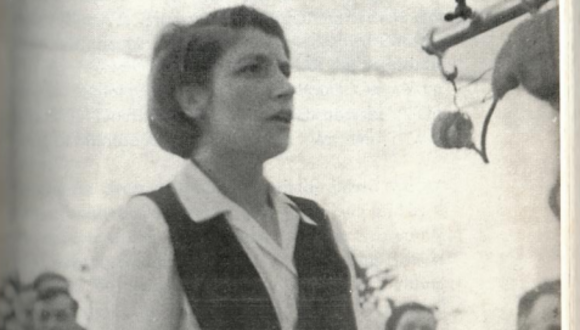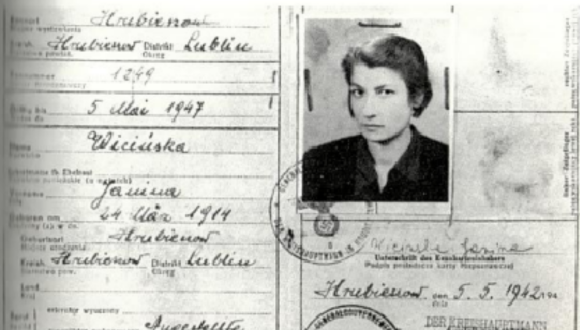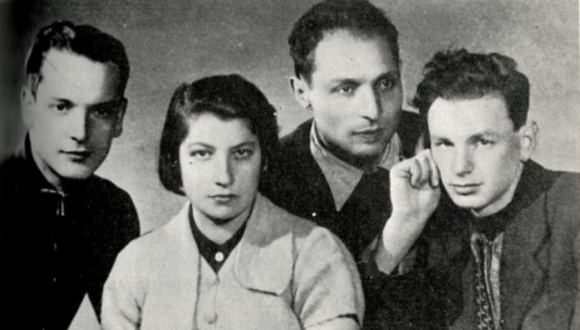Holocaust Remembrance Day 2023
Zivia Lubetkin
“We were aware of the fact that despite all our efforts we would not be able to save many Jewish lives, but it was clear to us nevertheless, that we could not continue as we had before. We would not go helplessly off to the slaughter. We would no longer die without a struggle. We would wage a battle for ourselves, for the Jews in the Homeland, for the Jewish in the Diaspora.”
Zivia Lubetkin was born in eastern Poland in 1914, and from a young age was a member of the ‘Dror’ Zionist Youth Movement. At the beginning of War World II, by the age of 25, Zivia decided to come to Warsaw to take part in the resistance actions. She became one of the leaders of the Jewish Underground Movement in Poland, and one of the leading members of the ‘Jewish Fighting Organization’ (Zydowska Organizacja Bojowa, ZOB) in Warsaw. [1]
On September 1st, 1939, the Germans attacked Poland, and in a few days the city was under Nazi occupation.[2] On November 11, 1940, all the Jewish people were forced to concentrate in one location in Warsaw [ghettoization]. The ghetto was 3.5 kilometers long and was encircled by a 3 meter high wall with wire fence. At its peak, the ghetto's population was believed to be 460,000 people. [3]
“With the promulgation of their various oppressive decrees, it became clear to us that the Germans were trying to destroy our spirit, crush our feelings of humanity, and blot out any remaining shred of our human dignity prior to carrying out their master plan. Therefore, we did everything in our power to counteract this onslaught of abasement. We resisted in various ways.”[4]

Zivia Lubetkin, In the Days of Destruction and Revolt (Tel-Aviv: Hakibbutz Hameuchad Pub. House : Am Oved Pub. House, 1981) p.65.
In July 1942 the Great Deportation to the East began, 265,000 Jews were sent by packed trains from Warsaw to the death camp Treblinka. After the deportations, only 55,000 Jews were left in the ghetto.[5] After the ghetto’s Jewish management failed to act against the deportations, the youth movements: ‘Dror’, ‘Hashomer Hatzair’ and ‘Akiva’ responded and established the ‘Jewish Fighting Organization in July 1942, which will act to resist the Germans.[6] On January 18th, 1943, the Germans planned to deport another 8,000 of the ghetto residents. ZOB chose to act and shoot the German forces despite not having enough time to prepare and not possessing adequate weapons. The deportations were stopped by this effort, and the Germans were only able to deport 5,000 people.[7]
In February 1943, Heinrich Himmler ordered the liquidation of the Warsaw Ghetto. On April 1943, on Passover eve, German forces surrounded the ghetto, while S.S. soldiers entered the ghetto walls with tanks, cannons, and guns in order to deport the remaining Jewish community. ZOB members and the ‘Jewish Military Union’ joined forces in an attempt to act against the Germans. 10,000 ghetto residents hid from the Germans in bunkers, adding to the resistance fighting front. For 27 days the ghetto residents did everything in their power to resist the German forces, while the resistance members attacked the German soldiers inside the ghetto walls.[8]
On April 23rd, the Germans systematically started to burn all the buildings in the ghetto. The resistance fighters were forced to abandon their positions, while many lost their lives.[9] Lubetkin fought with the resistance members and was one of the few people that managed to escape through the sewers to the Aryan side of Warsaw.[10]
“A line of dozens of fighters passes through the narrow canal. We walk bent and hunched through the slime carrying a candle in one hand. We follow each other in single file. We can’t see each other’s faces. We feel our way through the darkness and slowly press our way forward. We are exhausted and weak. We have nothing to eat or drink. The sewer isn’t a dark cave but more like a narrow, filthy hole. The minutes lag, every hour seems like an eternity. We trudge on for hours with no rest. […] You crawl through a sewer canal utterly exhausted, but your mind never ceases to function, never rests. Your entire being is centered on a reckoning of your life, and of the movement which has given that life meaning and purpose. The movement which has given you and few others like you the strength to overcome, to endure this terrible path to safety … you are alone with your thoughts.”[11]
On May 10th, 1943, the resistance members managed to escape the sewers.
“We saw each other for the first time in the light of day. We were filthy, covered in dirty, bloodstained rags, our faces emaciated and despairing, our knees caving in from weakness. It was a terrible and frightening sight. We had almost lost all semblance of humanity. Our burning eyes were the only evidence that we were alive. We stretched out in the back of the truck hidden from view, holding our guns. The truck, loaded with forty armed Jewish fighters, set off on its way in the heart of Nazi-occupied Warsaw.”[12]
In May 16th 1943, General Stroop bombed the big synagogue in Warsaw, and proudly declared that the Jewish Quarter in Warsaw is no more.[13]
After the Ghetto revolt, ZOB continued their actions, and joined forces with the Polish resistance movement, which established an office for false papers. They had a team of specialists which created false stamps that aid the resistance in issuing false identity papers in the conquered territories.[14] In the first days of the Polish rebellion in August 1944, the Jewish Fighting Organization published a declaration aimed for the survivors of Warsaw ghetto to continue their acts of resistant against the Germans. Although the remaining members of the resistance were only a few, they took part in the Polish revolt. Some of them were heavily injured and some ended up sacrificing their lives.[15]

Zivia Lubetkin, In the Days of Destruction and Revolt (Tel-Aviv: Hakibbutz Hameuchad Pub. House : Am Oved Pub. House, 1981) p. 225.
“At noon, on January 17, 1945, the soviet tanks arrived. A mob of people exuberantly rushed out to greet them in the town marketplace. The people rejoiced and embraced their liberators. We stood by crushed and dejected, lone remnants of our people.”[16]
After the war, Lubetkin was an activist in ‘Beriha’; an organization that helped European Jews "illegally" immigrate to Palestine. She made ‘Aliya’ to Israel in 1946, where she helped establishing the kibbutz Lohamei HaGeta'ot and its museum.[17] Zivia married the resistance leader Yitzhak Zuckerman. Their children Shemon and Yael were born in the Kibbbutz. Their granddhughter, Roni Zuckerman, was the first female Israeli jet fighter pilot in the Israel Defense Force.[18]
Zivia Lubetkin’s autobiography was published in Hebrew in 1979, titled; ‘In the Days of Destruction and Revolt’. In her autobiography, Zivia describes her memories from the Warsaw Ghetto revolt. Many of the quotes for this article were taken from her book. For more reading, please click here.
[2] Shlomit Shulhani, Gai Miron, The Yad Vashem Encyclopedia of the Ghettos During the Holocaust (Jerusalem: Yad Vashem, 2009) p. 897.
[3] From the Wiener Collection.
[4] Zivia Lubetkin, In the Days of Destruction and Revolt (Tel-Aviv: Hakibbutz Hameuchad Pub. House : Am Oved Pub. House, 1981) p. 47.
[5] From the Wiener Collection.
[6] Shlomit Shulhani, Gai Miron, The Yad Vashem Encyclopedia of the Ghettos During the Holocaust, pp. 912-913.
[7] From the Wiener Collection.
[8] Shlomit Shulhani, Gai Miron, The Yad Vashem Encyclopedia of the Ghettos During the Holocaust, p. 918.
[9] Ibid, p. 979.
[11] Zivia Lubetkin, In the Days of Destruction and Revolt, p. 245.
[12] Zivia Lubetkin, In the Days of Destruction and Revolt, pp. 251-252.
[13] Shlomit Shulhani, Gai Miron, The Yad Vashem Encyclopedia of the Ghettos During the Holocaust (Jerusalem: Yad Vashem, 2009) p. 920.
[14] צביה לובטקין, בימי כליון ומרד )קבוץ לוחמי הגיטאות: בית לוחמי הגיטאות ע"ש יצחק קצנלסון, 1980( עמ' 182.
[15] שם. עמ' 186-187.
[16] Zivia Lubetkin, In the Days of Destruction and Revolt, p. 274.





